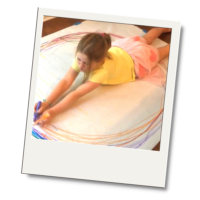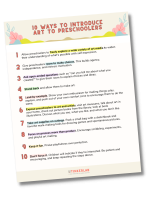When it comes to watercolor vs. tempera paint, which is best for kids? If you’re just starting out with making art with kids, you might be wondering about this. I’ll break down the differences and share when each type of paint could be more useful, and I’ll also share my favorite brands for getting started.
Sometimes the hardest part of setting up an art space is trying to decide which materials to keep in stock.
If you’ve been to an art store and felt overwhelmed by all the options, you might be wondering which paint/crayons/paper/all the things are worth investing in.
Even I get a little overwhelmed by all the options, especially when new products come out on the market.
Today we’ll take a look at watercolors vs. tempera paint, and discuss which is best for kids in different art situations. Both are useful and fun to have on hand, and it can help to know what each material excels at!

What’s the Difference Between Tempera Paint And Watercolor Paint?
Tempera Paint is thick, like yogurt. Something like starch or cellulose is mixed with pigment to give it this thick texture. Tempera paint, also called poster paint, is the inexpensive thick paint you’ll see in most schools.
Watercolor paint is thin, watery, and transparent. It’s generally made from pigment that’s suspended in a binder like gum arabic.
How are Tempera Paint And Watercolor Paint Similar?
Both paints are water-soluble, meaning you can wash brushes and clean it off hands with soap and warm water.
Both work well on paper.
You can also find washable and non-toxic options for each one.
How do I know if my Paint is Non-toxic?
Look at the labels on the bottle or packaging that say: “conforms to ASTM D-4236” or find the “ACMI – AP” seal to make sure your art supplies are not potentially hazardous to health. Art supplies sold in the United States must include the ASTM D-4236 label from the manufacturer.

What is Watercolor Paint Used for?
Watercolor paint is thin and watery. Ideally, use watercolors on watercolor paper and heavy paper like cardstock. You can also use watercolors on thinner paper, just note that the paper could buckle and the water could soak through.
What is Watercolor Paint not Useful for?
Watercolor paint is thin and doesn’t include an opaque binder, so it won’t show up in a meaningful way on cardboard, wood, or fabric.
What’s the Difference between Watercolor Paint Cakes (Pan), Watercolor Tubes, and Liquid Watercolor?
Watercolor cakes, which you are likely familiar with from your own elementary school days, require water to activate. This means these paints get a little diluted and will have less vibrancy and more transparency than other options. Cake paint is economical, easy to use, easy to clean, and easy to store. The paint dries after use and instantly works again next time you add water to it. The downside is they’re more difficult for toddlers and early preschoolers to use because they require the extra step/s of wetting the brush to wet and activate the paint. This can be frustrating to little makers, but once they get the hang of it, the upside is these paints are portable for on-the-go making and don’t require a lot of clean-up.
Watercolor tubes, that look like little toothpaste tubes, are mainly used more frequently by professional artists, mainly because they’re expensive and the paints can dry out if they’re left open. While I don’t use these watercolors with little makers, don’t let that stop you if you’d like to explore this option. They’re beautiful paints and require the addition of a watercolor palette for paint mixing. A palette knife isn’t necessary.
Liquid watercolors come in bottles that look like something shampoo might come in. These are one of my favorite paints to have for little makers because they can be used for so many painting and non-painting projects (in lieu of food coloring) such as coloring playdough, decorating Easter eggs, dripping onto paper with a pipette, and more. These are vibrant and easy to use. The downside is they stain fingers (and other things) and require you to pour individual colors into jars or containers to use them. Soap and warm water will eventually clean it from hands, but we’ve stained some tables and had a tough time getting it out. When painting, a bit more work is required than a watercolor cake, but you might find the tradeoff is worth it for the brightness and ease.
Which Watercolor Paints are Best?
Look for washable watercolors for younger kids.
My favorite inexpensive paint cakes are Crayola Washable Watercolors and Artist’s Loft (from Michael’s – not necessarily washable). My favorite professional brand if you want to splurge is Kuretake Gansai Tambi. These are pricey, but you’ll find that they last for years.
My favorite liquid watercolors are Sax Liquid Washable Watercolor Paint, Sargent Art Watercolor Magic, and Color Splash! Liquid Watercolor Paint.
What can I use if I don’t have Watercolor Paint?
If you don’t have watercolor paint, but you’re working on a project that requires it, there are options! You could use food coloring, diluted with a couple drops of water (or not, depending on the vibrancy of the project). You could also used thinned tempera paint. Scroll down to the question: Can you Dilute Tempera Paint or Watercolor Paint with Water?
What is Tempera Paint Used for?
Tempera paint, also known as poster paint, is thick like pudding. It’s great for the littlest hands because it’s responsive when little hands move it around, it’s bright, and it’s easy to use.
You can use it with thin brushes, thick brushes, sponges, fingers, and even feathers.
Use tempera on art projects that involve paper (heavy paper will be best for absorbing the paint), cardboard, poster board, and paper towel tubes.
What is Tempera Paint not Useful for?
Tempera paint doesn’t include a strong binder (like the latex that’s added to similar-feeling acrylic paint). What this means for the painting experience is tempera has a tendency to flake off non-paper surfaces. For this reason, tempera isn’t a great option for canvas, wood, the shiny side of cereal boxes, or plastic.
Tempera paint isn’t archival like acrylic or oil paint, meaning that it isn’t designed for longevity. Over time tempera could fade or flake off. Most of the time with kids paint crafts this isn’t an important consideration, but if you’re making an artwork that you might want to keep for a while, consider acrylic as an alternative to tempera.
Which Tempera Paints are Best?
Look for washable tempera paint. My favorite washable brand is Crayola Washable Paint.
Can You Dilute Tempera Paint or Watercolor Paint With Water?
Yes! Tempera paint and watercolor paint are water-soluble, and can be diluted with water. Just add a little water to the paint to thin it and make it appear more transparent.
Can You Make Watercolors from Tempera Paint?
You can! This is a great hack if you only have tempera paint on hand and want a more watery paint appearance. Fill a small cup with a couple tablespoons of water, then squeeze in tempera paint, little by little, until you reach the desired texture. You can then use this paint to create thin layers that have less opacity.
How Do You Make Tempera Paint at Home?
Gathering ingredients to make your own tempera paint is a great way to introduce kids to the origins of this paint medium. Tempera paint was originally made from a mixture of egg yolks, which act as a binder, and pigment. The pigments were created by grinding up plants, sticks, earth, and rocks to create new colors. These pigments were then added to the yolk to make paint. Due to the addition of egg, this paint has a gloss to it, and less of a matte finish than store-bought tempera. A fun experiment would be to make one batch of paint with egg yolks and another batch with egg whites, and see how they’re different. We’ll make a modern day version by adding liquid watercolor or food coloring to yolk to create homemade egg tempera paints that have the consistency of yogurt. Make your own egg yolk tempera paint here.
What is the Drying Time of Watercolor and Tempera Paint?
These paints dry fast especially if painted in thin layers. Depending on the brand, on how thick the paint goes down, and how watery your paint is, expect your paint to dry in as little as five minutes and as much as thirty minutes.
How do you Clean Up Water-soluble Paints?
These paints can be washed off hands with soap and warm water. With young children, it’s generally a good idea to look for washable paints, wear old clothes or an apron, cover work areas with a table cloth, set up a large tray like a cookie sheet under that art making area, and/or take paint outside. We like to say “yes” to kids when they’re making art, rather than “no” and anything we can do to create a “yes space” makes this so much easier.
Watercolor vs. Tempera Paint – The Verdict
As you can see it’s not an either/or situation when it comes to these two paints. They’re both fantastic additions to your kids’ home art studio, and can be used in different situations.
Recommended Projects for Kids using watercolor paint
Looking for paint project inspiration? Here are a few to begin with.
Glue and Watercolor Process Art
Recommended Paint Crafts for Kids using Tempera Paint
Stress-free Indoor Easel Painting (with tempera paint)
Make your own Egg Tempera Paint
If you’re wondering about other types of paint like gouache, ink, and acrylic paints, we can talk about that in another post!



